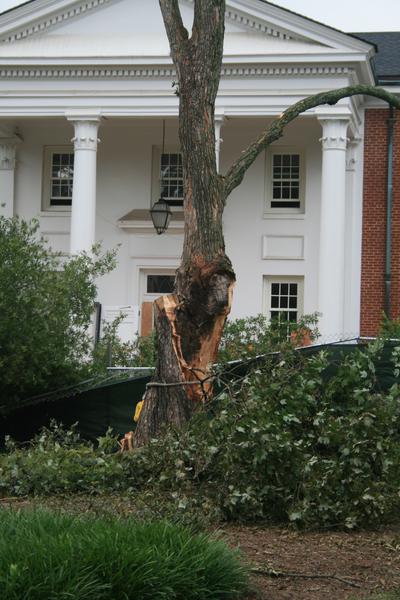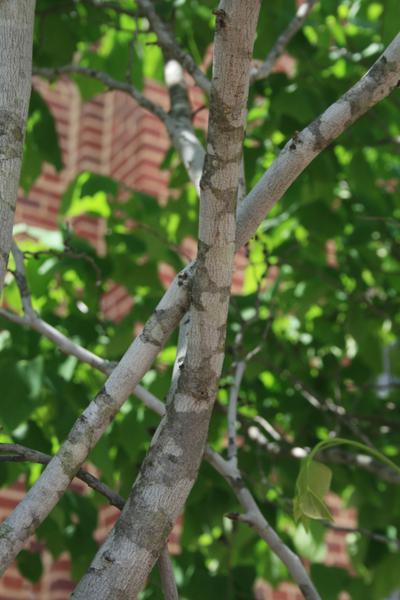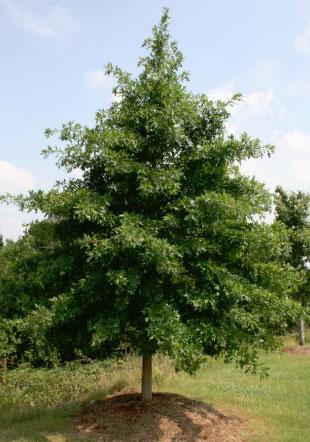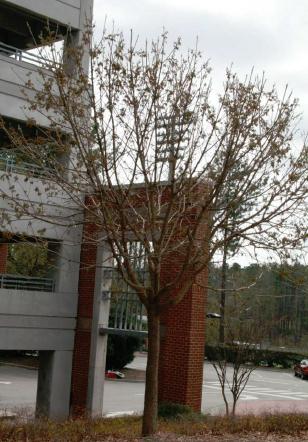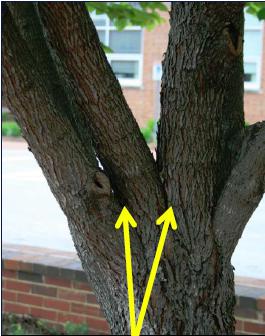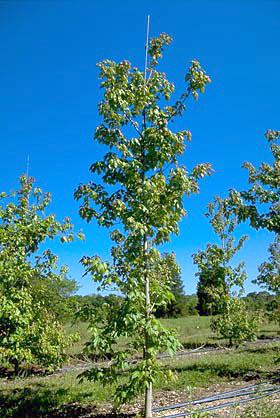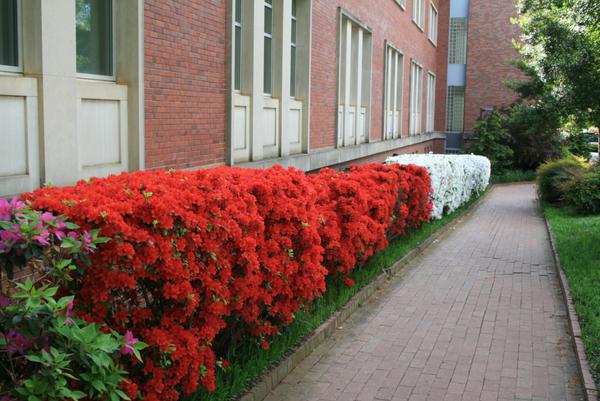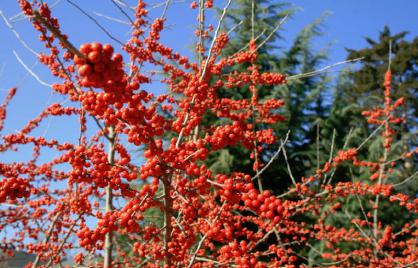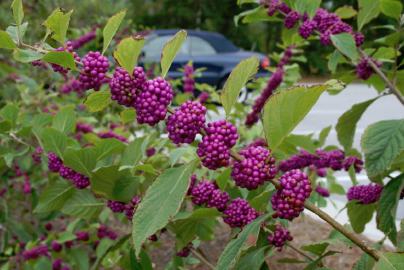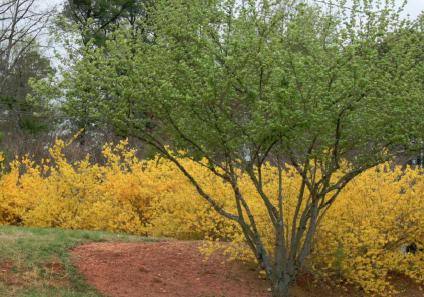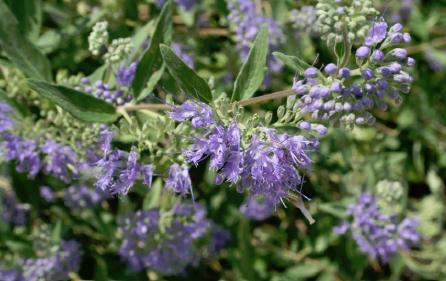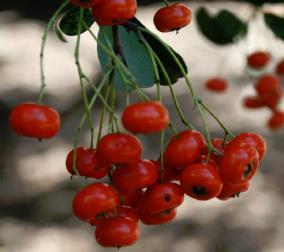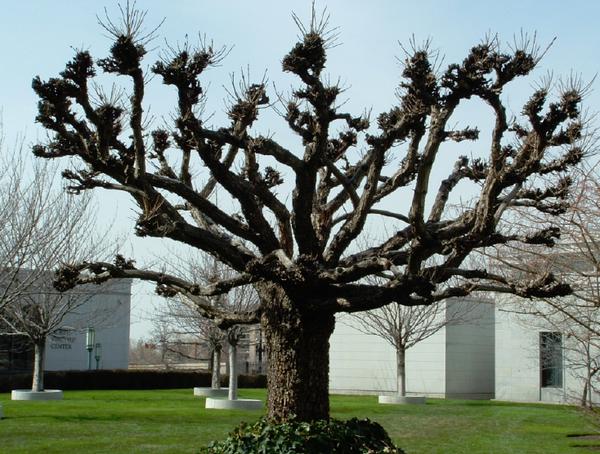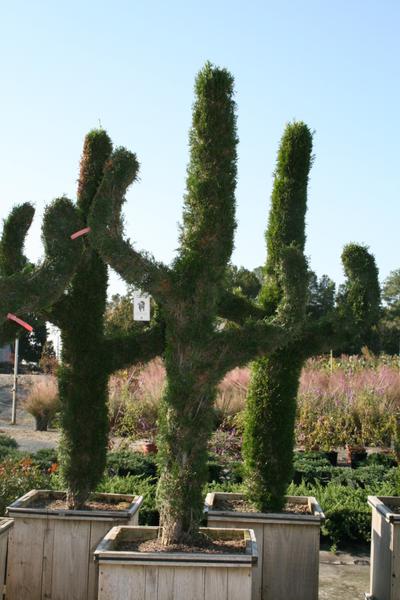Pruning is one of the most important plant management activities in urban and suburban environments. Sadly, it is often the most improperly implemented. Why? Incorrectly pruned trees and shrubs seldom die immediately. Years later, when the plant begins to decline, it is hard for us to recognize the link between the bad pruning and the plant’s death. If you are going to prune, proper timing, proper location of the cut, and proper technique are critical to plant health.
This is the first of four publications in the “Pruning Trees & Shrubs” series (AG-780-1 through 4) and introduces basic pruning concepts and key terms. Subsequent publications in the series provide more information on woody plant biology, necessary tools, and pruning guidelines for general purposes and specific species.
Definition of Pruning
Pruning describes the selective removal of plant parts to manage plant growth. Pruning is a science and an art. The biology of plant growth is the basis for the science, while the art comes in to some degree when you choose which branches to remove and how to shape certain plants. Getting the art right may take years of practice. But with enough practice and paying attention to the science, you will become proficient. The aim is to make a cut that minimizes plant injury, encourages quick wound closure, and redirects plant growth. REMEMBER, pruning inflicts wounds on a plant. You should have a good reason for removing living branches, particularly from trees. Minimizing the size and number of pruning cuts helps reduce the amount of wounding and potential negative effect on plant health. Learning as much as you can about plant biology will help you perfect your pruning technique.
Before pruning, ask yourself a few questions: What function is the plant serving in the landscape? Why am I pruning? Why am I removing this particular branch or portion of the plant? How will the plant respond to this pruning? Knowing the answers to these questions will help guide all your pruning activities.
Why Prune?
There are five main reasons to prune: (1) training plants to build a strong structure; (2) maintaining plant health for a long life, including foliage and stem health; (3) controlling plant size, which also includes controlling growth for clearance, improving the view, and reducing shade; (4) influencing flowering and fruit production; and (5) invigorating stagnating plants.
Training Plants for Strong Structure
If the goal for pruning trees in particular is a long life span, then developing a sound trunk and branch structure is key. Poor structure and defects such as codominant stems, cracks, and bark inclusions can shorten the lives of trees and lead to greater risk of branch or tree failure (Figure 1). Training young plants, then, particularly trees, is by far the most important type of pruning and often the one most overlooked. Structural pruning helps trees better tolerate stresses such as ice, snow, and wind and should start once plants are established in the site. The establishment period depends on the size and health of the plant material, weather conditions, plant installation techniques, and quality of site preparation. Here in the Southeast, it takes about six months per caliper inch for a tree to establish, as long as the tree is properly watered and the soil is conducive to good root growth. (The caliper is measured 6 inches above the root ball.) The first step directly after planting is to remove any dead or damaged branches. If you won’t be able to get back to this tree within a year or two, take out any codominant leaders (branches that will later contribute to poor form or could fail) or rubbing branches (Figure 2). Don’t overdo this first step, as the plant needs the photosynthates (carbohydrates) produced by leaves to help reestablish the root system.
Once a plant is established, you can begin an annual or biennial plan to address its structural issues. For trees, it is important to begin to build a strong scaffold or framework of permanent branches early in its life. This will reduce the need to remove big branches later in the life of the tree that will result in large wounds that can reduce the plant’s health and its defenses. Pruning young trees also reduces the chance for potential hazards such as branch failure that can occur when branches get larger and trees mature. In addition, building structure in a young plant reduces long-term costs because it requires minimal equipment (often only a hand saw or pole pruner), and it is much less expensive to prune smaller trees.
You must know the type of plant you are pruning to determine when and how to prune. Work with the plant’s growth habit as much as is possible to emphasize its natural form. While size describes the ultimate height and width a plant can obtain, form describes its shape (sometimes referred to as habit). Excurrent form or cone-shaped trees (Figure 3A) such as sweet gum, cedar, and some oaks (when young) have a central main leader or stem. Excurrent form trees may need little pruning to maintain a strong structure, although you may need to remove or shorten any branches competing with the central leader. If there is a codominant stem, you must remove it—the sooner the better. You may also need to remove lower limbs to obtain necessary clearance. Decurrent form trees have a rounded or spreading crown with no central leader and may be upright or have vase-shaped forms. Trees with a decurrent form (Figure 3B), such as maple, ash, and lacebark elm, may benefit from shortening or removing extremely vigorous branches to maintain the shape. These forms may be more likely to develop branches with weak unions and bark inclusions (Figure 4A), thereby requiring more frequent pruning to develop strong structure. U-shaped branch unions provide a sound base structure for trees as they mature (Figure 4B). Lightly thinning the canopy helps all forms of plants develop a healthy structure.
Depending on the plant’s function in the landscape, you may need to remove the lower limbs to a specific height so people can walk under the plant, drive by, or obtain sufficient clearance for a lawn mower. For example, cities may maintain street trees with a clear trunk of at least 8 feet above the sidewalk and 14 feet along the street. Experts refer to this type of pruning as either crown elevation or crown lifting. While it is important to remove branches when they are small in diameter, wait until the tree has been in the landscape for a few years before removing all of the lower branches growing along the main trunk. Much of the current arboriculture research indicates the tree will develop better form over time and will be less prone to windthrow if individual branches growing along the length of the trunk are retained while the tree is young (especially in the nursery) to help build good taper (Figure 5).
When maintaining a hedge or screen, however, you do not want to remove lower branches because a hedge provides privacy and a boundary. But, you do want to prune for strong structure on large shrubs, such as some cultivars of crape myrtle.
Take note—if trees are growing along the street, often in a grassy strip between the sidewalk and curb, they belong to the city, and only its employees are typically allowed to prune these.
To develop the greatest strength, ensure that branches selected for permanent scaffolds have a wide, U-shaped branch union where they attach to the trunk. Relative branch size, however, is more important than the angle of attachment. The ratio between the diameter of the trunk and lateral branches, termed aspect ratio, should be less than about one-half that of the parent branch or trunk. Prune branch ends to slow growth of large, potential scaffold branches to ensure strong attachment and reduce competition with the leader, ensuring the main trunk’s dominance. You can accomplish this by thinning about 15 to 20 percent of the foliage on these branches or by trimming off some of the terminal growth during young-tree training. The earlier you begin training the tree, the better. If you must make a choice, select scaffolds with wider angles of attachment and growth that is more horizontal. These tend to have less vigorous growth. In some decurrent species, the lowest branches often surpass the growth of the trunk and upper branches. As you work to train the tree, make sure to keep an eye on these branches so they do not outgrow the leader. There may be no need to remove them initially; you may be able to subordinate them by reducing the terminal to a smaller branch or bud through a reduction cut. Remove branches with bark inclusions to their point of attachment because this often indicates a weakness.
Maintaining Plant Health
Any time of year is the right time to remove dead or broken branches. Maintaining plant health means removing weak or damaged, crossing, crowded, or diseased branches. Opening the crown to light and increasing air circulation will potentially help reduce the incidence of disease, help minimize interior dieback, and reduce possible losses in storms. Be light-handed when opening up the crown, only removing codominant stems or other branches that may negatively affect good structure, leaving more branches now than the tree will ultimately retain as it matures. Do not prune if you do not know why the tree needs pruning. Once you select the lowest permanent branch, consider those remaining below it as temporary. You will remove these temporary branches over time as the tree grows and builds the needed taper (Figure 6). You may need to tip-prune overly vigorous temporary branches to keep them from competing with the leader or potential permanent branches. Later in this publication, we cover specific details regarding where and how to remove branches.
Controlling Growth (for Clearance, Improving the View, Reducing Shade, and Wind Resistance)
This is the most common type of pruning. Often the reason we must control growth is that we placed a plant in the wrong place. If you must significantly prune a plant every year or every few years to control size, it is the wrong plant for that site! The first step to minimizing the need for growth control is to select plants that can grow to their mature size in the allotted space. Doing so means understanding the mature height and width of each selection. Many plants have cultivars or varieties that vary in height and width from the original species; select the cultivar that fits the available space. For example, there are many cultivars of crape myrtle ranging in height from 3 or 4 feet to well over 25 feet.
That said, on occasion you will want or need to control the size of a plant and the direction in which it grows. For example, directional pruning can minimize interference with hardscapes, overhead wires, or other plants and minimize the need for severe pruning in the future.
In particular, pruning shrubs to control size is a common management tool. Rejuvenation is a type of pruning that you can use to control growth and to invigorate stagnating plants. Shearing, espalier (Figure 7), topiary, pleaching (Figure 8), and pollarding are all means of controlling plant growth. Most of these require consistent, yearly pruning to maintain the desired shape and size.
In certain communities, residents are prohibited from removing trees to improve their view of a lake, mountain, or other amenity. In such cases, however, residents are often allowed to reduce the height of trees or shrubs by performing reduction cuts. Reducing the crown of older trees is discouraged because it can lead to extensive decay and physiological stress. It is best to contact a certified arborist to assess the need for crown reduction pruning and to find out the impact it would have. The aim of crown reduction is to remove terminal branches back to laterals of sufficient diameter (at least ⅓ to ½ of the branch being removed) to take over production of photosynthates for the branch lost. It is best to perform crown reduction only on young trees, and only if absolutely necessary.
Later in this publication, we will discuss particular types of pruning cuts to help you direct growth, thin, and head back or reduce plant size.
Influencing Flowering and Fruiting
Pruning affects the balance between vegetative growth and flower bud formation. Timing is critical when pruning for flower production. Prune spring-bloomers after bloom (Figure 9), and prune summer- or fall-bloomers in either late fall or late winter/early spring. This type of pruning is more common on shrubs than trees, with the exception of fruit-producing trees such as apples, peaches, and pecans.
Remember, if you prune at the wrong time of year, you may be removing flowers that will produce the fruit you really want (Figure 10A and Figure 10B). Plants that bloom in spring will typically produce their fruit in late summer or autumn.
For guidance on pruning fruit trees and other common fruit-producing species, check out Training and Pruning Fruit Trees in North Carolina (NC State Extension publication AG-29) by Michael Parker, Extension horticulture specialist.
Invigorating Stagnating Plants
After growing in a site for many years, plants may often lose vigor and need to be revitalized. Environmental stressors, such as heat, drought, flooding, and wind, can take their toll on plants. How do you know when a plant needs to be revitalized? Excessive dieback, increased production of epicormic sprouts on tree limbs, reduced flower and fruit production (particularly on shrubs), smaller and off-color foliage, thinner canopy, and reduced growth overall are all signs that a plant is lacking vigor.
You can easily rejuvenate established shrubs that lack vigor. It is not as straightforward to do so with trees. Often there is a suite of issues that have led to decline in a tree, and simple pruning will not remedy the situation entirely. Later in this series you will learn how to perform rejuvenation pruning.
How Will the Plant Respond to Pruning?
Before you begin, you must know why you are pruning the plant or removing a particular branch, and you must understand how the plant will respond. Here are some important tips.
When pruning young plants and mature plants with few flowers you will get one of two responses.
- Invigoration of individual branches is the common response to pruning (Figure 11).
- The root system can supply more water and nutrients to the remaining shoots, leaves, and buds.
- These shoots grow faster and later into the season, and leaves may be larger and darker green overall.
- Dwarfing of the total plant can also occur.
- Fewer shoots have less total leaf area and buds.
- After shoot growth stops, the pruned plant has less time to produce photosynthates for next season because it has grown so late in the season. This means less total growth—thereby dwarfing the plant.
- Dwarfing is more common on severely pruned plants.
- The aboveground and belowground portions (roots) of the plant will likely be in balance. The top and roots will be smaller than if the plant had not been pruned.
Whether a plant is invigorated or dwarfed depends on the severity of pruning. If you want to slow the growth or subordinate a branch, prune it more severely. If, however, you want to encourage growth, prune lightly or not at all. To encourage young shoots, prune or remove branches that shade or compete with the one you are trying to encourage. Removing dead, weak, or heavily shaded branches will have little or no effect on growth, however, compared to the removal of healthy branches.
Top-pruning of young plants reduces photosynthates and auxin that go to the roots. In deciduous plants, spring root growth may be delayed by removing shoot terminals. Research has shown that not pruning trees with expanding buds and leaves will stimulate enough root growth to more than compensate for any increased transpiration due to more leaf biomass. The key is to prune only for a specific reason!
In more mature plants, pruning is not likely to lead to dwarfing. In addition, you cannot encourage invigoration in older plants as easily as you can with younger plants. If pruned during the dormant season, an established plant that flowers heavily on year-old wood will produce greater shoot growth and leaf area by the end of the growing season. You will be removing both leaf and flower buds, and no new flower buds will form in the spring. Shoots will grow from remaining leaf buds and produce more growth than if you had not pruned. There will be more leaf and shoot buds than flower and fruit buds. If you prune severely enough, you can encourage substantially more vegetative growth in the future and increase fruit size (though there may not be as many fruits). Pruning a stagnating plant can stimulate new growth and increase overall biomass.
The only pruning you should need to do on mature plants, particularly trees, is thinning. Removal cuts remove branches from the trunk or larger branch at the branch collar, using the branch bark ridge to guide the cut and achieve the correct angle. Topping is a type of heading cut. It removes large portions of biomass and leads to an increase in stem development, but it is not an acceptable practice.
Plants That Flower on Year-Old Growth
Keep pruning to a minimum and withhold nitrogen fertilizer to encourage more flower bud production and blooming at a younger age. Pruning concentrates nutrients (particularly nitrogen) into fewer shoots, encouraging vigorous growth and reducing flower production (by reducing flower buds).
Alternatively, if the plant is not very vigorous, pruning puts more nutrients into fewer shoots, increasing the amount of nitrogen to each, which can lead to more flower buds for the following growing season.
Many shrubs that flower on old growth can be controlled with a rejuvenation pruning right after blooming. The following year, the plant will produce a lot more vegetative growth and loads of flowers (Figure 12).
Plants That Flower on Current-Season Growth
Pruning prior to the growing season will invigorate the plant and encourage more flower buds on lateral stems (Figure 13). Plants that flower on terminals will produce larger flowers or flower clusters. Keep in mind, though, that whatever you do to encourage flower production also encourages fruit (Figure 14), unless you prune heavily before fruit develops.
Topping
At this point, we want to address a type of pruning often done to trees. While we use heading cuts to shear shrubs and herbaceous plants, this type of cut should not be done to trees. A heading cut done on a tree is called topping. Topping done on mature trees is an unacceptable practice that negatively affects tree health. Main branches are cut back to stubs at random locations. After topping, numerous epicormic sprouts grow very quickly from latent buds below the pruning wound (Figure 15). This regrowth may be dense, vigorous, and upright. However, the new shoots are weakly attached to the stem, held on only by the most recent growth ring. Because the cuts are made on larger branches without regard to the branch collar, it will be difficult for the tree to close the wound. It is likely that fungal organisms will cause decay to form in these wounds. As a result, this vigorous sprout growth is weakly attached to decaying wood and becomes a potential safety concern. Aside from the unattractive nature of topping cuts, the more serious concerns are an increased failure potential and decreased tree health. DON’T TOP PLANTS (including crape myrtles)! It is unprofessional, unattractive, and destructive. Pollarding (Figure 16) is a proper method for reducing the height of trees and for creating a unique habit.
Summary
So, before you pick up the pruning tools, follow these easy steps:
- Know why you are pruning and how the plant will respond. Have a good reason for removing live branches.
- Know the plant you are pruning. Understand its function in the landscape so that you may better prune it.
- Learn everything you can about woody plant biology so you understand the science of pruning, and take time to perfect the art of pruning. It does take practice.
- Pick the right plants for your site to allow your plants to reach their genetic potential and beauty. This will cut down on your need for pruning!
- Understand how plants change over time, and adjust your pruning methods and timing accordingly.
- Never top trees!
Have fun pruning, and check out the rest of the publications in the “Pruning Trees & Shrubs” series to learn more:
2. Tools to Make the Cut (AG-780-02)
3. General Pruning Techniques (AG-780-03)
4. How to Prune Specific Plants (AG-780-04)
This series is a revision of a previous publication: Powell, M. A. 1998. Pruning Trees & Shrubs: A Guide for Grounds Managers (AG-071). Raleigh: NC State University, NC Cooperative Extension.
Important Terms
Know these terms before making the first cut. Many of these terms occur throughout this publication and in the Pruning Trees & Shrubs series. All of these terms will help you with your woody plant biology studies.
aspect ratio—the ratio between branch diameter and trunk diameter measured just beyond (above) branch union; ideally should be less than ½ the diameter of the trunk.
auxin—plant growth hormone that inhibits shoot formation from buds or stems aboveground and initiates root growth below ground.
bark inclusion—bark developing between two codominant stems; weakens the union between the branch and trunk and can be a factor in branch failure.
biomass—describes any or all of the total amount of leaves, stems, buds, or roots.
branch bark ridge—a mustache-like layer of bark located on the upper side of a branch in the branch union.
branch collar—the wood at the branch base that turns abruptly downward to wrap around trunk wood where a branch with a small aspect ratio joins with a larger parent stem.
caliper—the diameter of a tree’s trunk measured 6 inches above the ground on trees up to and including 4 inches in diameter; trees more than 4 inches in diameter are measured at 12 inches above the ground.
canopy—the total area of the branches of a tree or large shrub (crown).
codominant stem or leader—a stem or branch growing at about the same rate and nearly of the same diameter as another stem; both stems originate from the same union. A codominant stem does not have the same structure as a true branch.
crown—refers to either the area of the main stem that is just underground or the total area of the branches of a tree or large shrub (canopy).
cultivar—a variety of plant that was produced from a natural species and is maintained under cultivation.
decurrent form—round-headed and spreading crown; has no main leader.
dieback—the death of tips of shoots or branches, typically spread down the stem and caused by stress, disease, or damage.
directional pruning—pruning cuts made at the branch collar or to a lateral intended to control the direction of branch growth.
elevate (crown raising)—the removal of low branches to produce a taller, clear trunk that increases access under the canopy.
epicormics—shoots that develop from latent buds under the bark; often arise close to pruning or other wounds and from old branches or the trunk; watersprouts and suckers are epicormic shoots.
espalier—a plant trained through pruning to grow in a formal, two-dimensional form.
excurrent form—main stem or leader outgrows and subdues lateral branches; a cone-shaped crown.
form (habit)—the characteristic shape, appearance, or growth form of a plant species. It develops from specific genetic patterns of growth in combination with environmental factors and is part of the organization of every plant.
heading cut—a pruning cut that removes only a portion of a stem, often an internode (a cut made between two buds or nodes).
latent bud—bud that fails to develop in the season it was formed but remains dormant and may later be stimulated into growth. If a branch breaks or is removed just above a latent bud, the bud will likely develop a new shoot to replace the lost wood.
lateral—bud or branch located along the length of a stem or branch.
leader—a stem that forms the main axis of a woody plant; a plant may have one or many leaders.
node—point on a stem where a leaf (bud) was or is attached.
photosynthates—the sugars and starches (foods) produced in leaves through the process of photosynthesis.
pleaching—informally weaving tree branches together to form a living wall or fence.
pollarding—heading back all annual (or biannual) growth to the same point on a branch (scaffold branches, typically), creating a knobby growth called the pollard head that will sprout again the following year; not to be confused with topping, which removes branches to a different point on the branch each year.
reduction cut—pruning cut that reduces the length of a branch or stem back to a live lateral branch large enough to assume apical dominance, typically at least ⅓ to ½ the diameter of the cut stem.
rejuvenation—involves removing oldest branches by pruning them near the ground. Rejuvenation can be done in stages or all at once, depending on pruning goals; plants should be fully established prior to rejuvenation.
removal cut—removing branches at the branch collar; typically done to open the canopy to air movement and increase light penetration.
scaffold branches—major branches that will make up the primary crown of a tree.
shearing—tip-pruning without selecting individual laterals or buds (topiary or hedge maintenance).
structural pruning—pruning method that influences the orientation, spacing, growth rate, strength of attachment, and ultimate size of branches and stems, resulting in a strong tree.
subordinate (subordination)—slowing the growth rate of a stem or branch by removing its terminal or end portion, or by removing lateral branches from it (or a combination of these) so other portions of the tree grow faster; also referred to as suppression.
sucker—a shoot that arises at or below ground level from a plant’s root or underground stem; on grafted plants, any shoot that arises below the graft union (from the root stock).
taper—a decrease in trunk diameter with height; building taper is important in the development of a strong trunk that will be able to withstand winds.
terminal—a bud located at the tip of a twig or shoot; apical bud.
thinning—in pruning, increasing light and air penetration and reducing mechanical stress by removing branches primarily from the outer edge of the entire crown, or from selected branches.
tip-pruning—pinching out or cutting back the growing tip of a shoot either to encourage side shoots or to remove damaged growth.
topiary—practice of pruning a shrub or tree to create a shape or living sculpture; typically accomplished with shearing or heading-back cuts.
topping—heading a large branch or trunk, leaving large stubs; removes the plant’s natural form and can lead to internal decay and extensive sprout development.
transpiration—evaporation of water vapor mostly through stomata on the underside of leaves.
union—the angle between two branches or between a branch and the trunk.
U-shaped branch union—broad branch angle shaped like a “U,” which is less prone to breakage because it is strongly attached to the main trunk or a larger branch.
watersprout—a vigorous vertical shoot growing from a branch above the ground or graft union, mainly from latent buds along the trunk or older branches and often stimulated by overpruning or some other stress.
windthrow—tree failure due to uprooting by wind or water.
Publication date: March 31, 2020
Reviewed/Revised: March 5, 2025
AG-780-01
N.C. Cooperative Extension prohibits discrimination and harassment regardless of age, color, disability, family and marital status, gender identity, national origin, political beliefs, race, religion, sex (including pregnancy), sexual orientation and veteran status.

